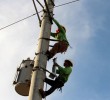In the first place, the ‘artificial crisis,’ according to Bagong Alyansang Makabayan-Southern Mindanao, was a result of the government’s sellout of two diesel-powered power barges in the island, the power barge No. 117 in Nasipit town, Agusan del Norte and No. 118 in Maco, Compostela Valley, to the Aboitiz-owned Therma Marine Incorporated. These power barges have a combined 200-MW generation capacity.
By MARILOU AGUIRRE-TUBURAN
Davao Today
DAVAO CITY, Philippines — Militants here challenged the newly installed head of the Department of Energy (DOE) Jericho Petilla to “immediately act” on the so-called “artificial power crisis in Mindanao.”
Cherry Orendain, regional spokesperson of the youth group Anakbayan, said Petilla must look into the said 500-megawatt power supply shortage being used “to justify the construction of more coal-fired power plants (CFPP)” in the island.
According to Orendain, the Agus-Pulangi hydropower plants’ installed capacity of 982 MW “can be maximized if only the Aquino administration will prioritize its rehabilitation.”
In the first place, the ‘artificial crisis,’ according to Bagong Alyansang Makabayan (Bayan)-Southern Mindanao, was a result of the government’s sellout of two diesel-powered power barges in the island, the power barge No. 117 in Nasipit town, Agusan del Norte and No. 118 in Maco, Compostela Valley, to the Aboitiz-owned Therma Marine Incorporated. These power barges have a combined 200-MW generation capacity.
Over the last month, recurring brown outs have occurred in many parts of Mindanao like in North Cotabato province and General Santos City.
Bayan insisted that power crisis was “artificial” given that the island has a number of renewable energy sources like the Mindanao Geothermal Production Field (MGPF) in Kidapawan City, Cotabato province and the the Agus-Pulangi hydropower plants (APHPs) spanning the provinces of Bukidnon, Lanao del Norte and Lanao del Sur.
The APHPs which supply 50 percent of Mindanao’s power requirements have a current generating capacity of only 100-150 megawatts (MW). However, its total installed capacity is 982 MW. Meanwhile, the MGPF has a capacity of 106 MW.
With the sale of power barges to profit-driven private companies, rates have gone up forcing small electric cooperatives to resort to rotating brown-outs, Bayan said.
Bayan said, one of the biggest factors to the power woes in Mindanao is the government’s “failure to rehabilitate and maintain” the APHPs. The latter have an installed capacity of 320 MW but “due to siltation and degraded watersheds, its capacity to generate electricity has reduced to 100-150 MW.”
It added, the Napocor “failed to maintain and rehabilitate APHPs” because the Psalm (Power Sector Assets and Liabilities Management) “did not provide the needed funds requested by the Napocor (National Power Corporation) to repair and rehabilitate it.”
“It seems they (government) prefer power sourced from CFPPs which are even more expensive,” Orendain said.
Coal, power barges and diesel, according to Orendain, cost PHP 9 (USD 0.22) per kilowatt hour (kwh) compared to the PHP 2/kwh (USD 0.05) for hydroelectric power and PHP 2.80/kwh (USD 0.07) for geothermal power.
Six CFPPs are slated for construction in the island based on the June 29 data from the DOE. These, Orendain said, belong to private investors.
The Sagittarius Mines Inc. plans to build a 500-MW CFPP in Malalag, Davao del Sur while the Therma South, a subsidiary of Aboitiz Power, plans to put up a 300-MW CFPP in Toril District, Davao City.
The Alsons Consolidated Resources, a member of the Alcantara Group, is set to establish a 200-MW CFPP in Sarangani while the San Miguel Corporation is set to install one in General Santos City.
The SPI eyes expansion of its 150-MW coal-fired PP in Villanueva, Misamis Oriental and the Philippine National Oil Company-Exploration Corporation will set up a 10-MW CFPP in Zamboanga Sibugay.
During the Mindanao Power Summit held here in April, the DOE said CFPP and power barges will also be established for the Mindanao grid by the Alcantaras and business tycoon Henry Sy which could generate 700 MW of power.
Currently, the island has one CFPP owned by the Steag State Power Inc. (SPI) which generates 232 MW of power.
Alternatives
Bayan Muna Party list representative and Makabayan senate bet Teddy Casiño said that there are options available if only the government is serious in addressing issues of the power sector.
Among these, he said, include the recommendations during the April Davao summit like the deployment of power barges of the Napocor in Mindanao, development of renewable energy sources, and the creation of the Mindanao Power Corporation to oversee the operations of the existing and future power plants in Mindanao.
Casiño expressed alarm over government’s plan to sell Napocor power barges that are supposed to be deployed in Mindanao.
“Former DOE Sec. Almendras promised five power barges that would be deployed to Mindanao but they are still nowhere to be seen because the DOE wants to sell them first. We should not wait for these barges to be privatized since Napocor can operate them so that the cost would not be too high,” he added.
Not unlike his predecessor
More than a week after Petilla’s new appointment, former Bayan Muna Representative Joel Virador said that Petilla is “still for the privatization of power plants.”
Virador said Petilla “mouths off the same policy of foreign lending institutions same as that with PNoy.”
Thus, “we can expect no significant change in the energy policy from his predecessor,” Virador said of Petilla.
Bayan spokesperson Sheena Duazo said that Petilla can offer the Filipino people many promises “but the fact remains that the DOE will align its policies with the PPP (private-public partnership) program of the Aquino government which is basically biased to the interest of the big capitalists and are clearly anti-poor.” (Marilou Aguirre-Tuburan/davaotoday.com)










